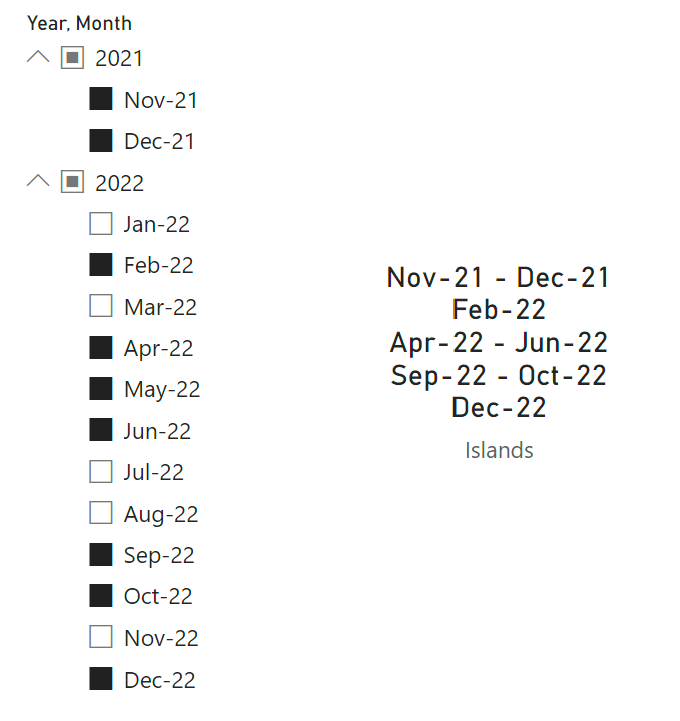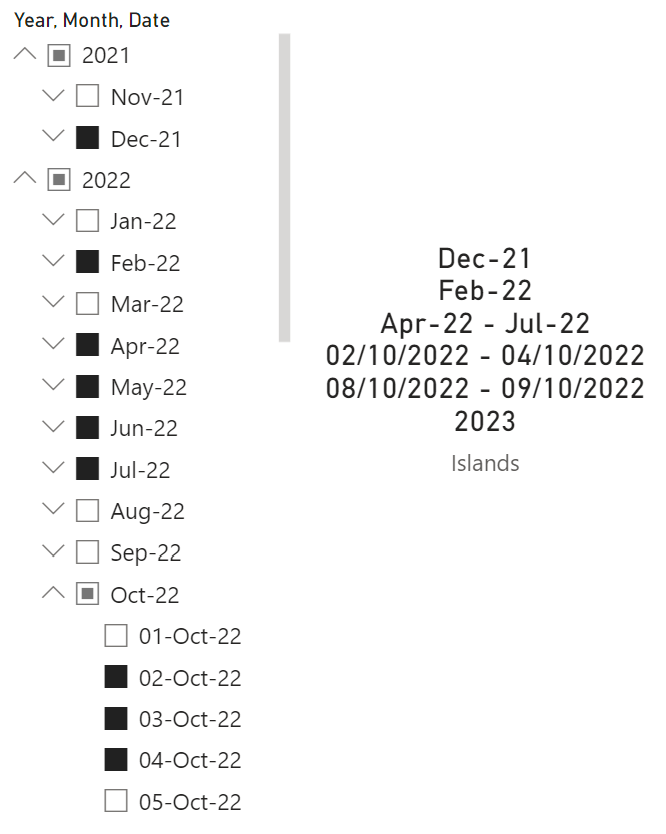Solving the Islands Problem in DAX
Solving the Island problem in DAX, to return a list of continuous Dates
A while ago the SQLBI guys release a blog providing a solution for Displaying a list of selected months. The input is a selection of filter month, and the output list these months, with contiguous sequences grouped together. This was done by looking at leading and lagging values to detect edges of continuous sequences. This problem falls into the classic Island Problem, and there is another nice way to solve this.
Simple Solution¶
The Island problem states that we want to group ranges of continuous sequences. There is also a similar but opposite Gaps problem, which detects missing values in a sequence. To solve the Island problem we can add a extra column with sequential integers, which increases at the same cadence.
Sequence considerations
If we have daily the sequential sequence would need to increase by 1 for each row. If we have weekly data the sequence would need to increase by 7.
We can calculate the difference between the two sequences. If there is no gap then the difference will be constant. If there is a gap the difference will change, and denoting a new island. This is demonstrated with this example.
DEFINE
VAR DateFilter =
TREATAS(
{
DATE(2021, 11, 01),
DATE(2022, 11, 02),
DATE(2022, 11, 03),
DATE(2022, 11, 06),
DATE(2022, 11, 07),
DATE(2022, 11, 08),
DATE(2022, 11, 11),
DATE(2022, 11, 12)
},
'Dates'[Date]
)
EVALUATE
CALCULATETABLE(
ADDCOLUMNS(
VALUES( Dates[Date] )
,"@RowNumber"
, RANK( DENSE, VALUES( Dates[Date] ), ORDERBY( Dates[Date], ASC ) )
,"@Islands"
,DATEDIFF(
RANK( DENSE, VALUES( Dates[Date] ), ORDERBY( Dates[Date], ASC ) )
,Dates[Date]
,DAY
)
)
,DateFilter
)
| Date | @RowNumber |
@Islands |
|---|---|---|
| 02/11/2022 00:00:00 | 1 | 44866 |
| 03/11/2022 00:00:00 | 2 | 44866 |
| 06/11/2022 00:00:00 | 3 | 44868 |
| 07/11/2022 00:00:00 | 4 | 44868 |
| 08/11/2022 00:00:00 | 5 | 44868 |
| 11/11/2022 00:00:00 | 6 | 44870 |
| 12/11/2022 00:00:00 | 7 | 44870 |
As you can see there are 3 separate continuous sequences, and each group gets a distinct [@Island] value.
We can use this as a base for the final solution.
// Islands
VAR DataSequence =
ADDCOLUMNS(
VALUES( Dates[Date] )
, "@Islands"
,DATEDIFF(
RANK( DENSE, VALUES( Dates[Date] ), ORDERBY( Dates[Date], ASC ) )
,Dates[Date]
,DAY
)
)
VAR Islands =
SUMMARIZE(
DataSequence
,[@Islands]
,"IslandString"
,VAR MinDate = FORMAT( MIN( Dates[Date] ), "mmm-yy" )
VAR MaxDate = FORMAT( MAX( Dates[Date] ), "mmm-yy" )
RETURN
IF( MinDate <> MaxDate, MinDate & " - " & MaxDate, MaxDate )
)
VAR result = CONCATENATEX ( islands, [IslandString], " | " )
RETURN
result
Extended Solution¶
This works well for a given granularity, but what about if we want to show a mixture of selected days, months and years. We can extend our solution as follows.
// Island Extended
Islands =
VAR DataSequence =
ADDCOLUMNS(
SUMMARIZE(
Dates
,Dates[Year]
,Dates[Month]
,Dates[Date]
)
, "@Islands"
,DATEDIFF(
RANK( DENSE, VALUES( Dates[Date] ), ORDERBY( Dates[Date], ASC ) )
,Dates[Date]
,DAY
)
)
VAR Islands =
SUMMARIZE(
DataSequence
,[@Islands]
,"IslandString"
,VAR MinDate = MIN ( Dates[Date] )
VAR MaxDate = MAX ( Dates[Date] )
VAR MinYear = CALCULATE( MIN( Dates[Date] ), ALLEXCEPT( Dates, Dates[Year] ))
VAR MaxYear = CALCULATE( MAX( Dates[Date] ), ALLEXCEPT( Dates, Dates[Year] ))
VAR MinMonth = CALCULATE( MIN( Dates[Date] ), ALLEXCEPT( Dates, Dates[Month] ))
VAR MaxMonth = CALCULATE( MAX( Dates[Date] ), ALLEXCEPT( Dates, Dates[Month] ))
VAR GranularityCheckStart =
SWITCH(
true
,MinDate = MinYear && MaxDate = MaxYear
, CALCULATE( MAX( Dates[Year] ), Dates[Date] = MinDate )
,MinDate = MinMonth && MaxDate = MaxMonth
, FORMAT( CALCULATE( MAX( Dates[Month] ), Dates[Date] = MinDate ), "mmm-yy" )
,MinDate
)
VAR GranularityCheckEnd =
SWITCH(
true
,MinDate = MinYear && MaxDate = MaxYear
, CALCULATE( MAX( Dates[Year] ), Dates[Date] = MaxDate )
,MinDate = MinMonth && MaxDate = MaxMonth
, FORMAT( CALCULATE( MAX( Dates[Month] ), Dates[Date] = MaxDate ), "mmm-yy" )
,MaxDate
)
return
IF( GranularityCheckStart = GranularityCheckEnd, GranularityCheckStart, GranularityCheckStart & " - " & GranularityCheckEnd )
)
VAR result = CONCATENATEX ( islands, [IslandString], UNICHAR( 10 ), [@Islands], ASC )
RETURN
result

